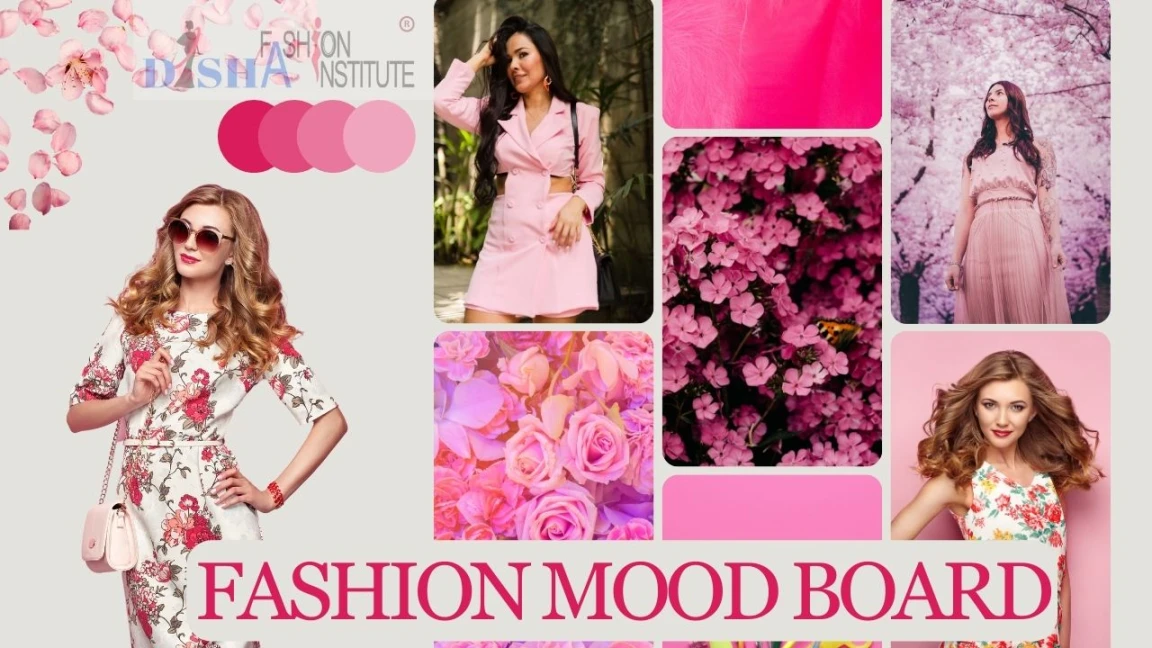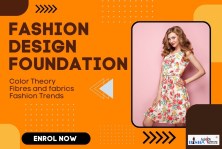What is Fashion Mood Board?
A fashion mood board is essentially a visual tool that communicates our concepts and visual ideas. It's an arrangement of images, materials, pieces of text, etc., intended to evoke or project a particular style or concept. In fashion, mood boards are used by designers to collect ideas, inspiration, and elements that reflect the feeling, direction, or aesthetic of what they want to convey in a fashion line or a specific piece of clothing.
A fashion mood board helps fashion designers to visualize and communicate their design concepts to clients, team members, and collaborators. A mood board can include anything from photographs, fabric swatches, and magazine clippings to typography, patterns, and color palettes.
A fashion mood board is a visual language that directs the entire design process, from concept development to final production. It helps them refine and articulate their vision and ensure that all design elements are working together harmoniously.
Table of Content
Why You Need a Fashion Mood Board For Your Apparel Brand?
The purpose of a fashion mood board in fashion design is to visually communicate and convey a design project's overall aesthetic and feel. It is a tool that helps the designer to collect and organize their ideas and inspirations and to develop a cohesive and consistent visual language through adjustments and alterations to their design concept.
Establishing a clear vision
Fashion mood boards help designers define and refine their ideas and inspirations and establish a clear visual direction for their collection.
Communicating With Others
Mood boards enable communication of the designer’s vision to clients, team members, and collaborators, ensuring everyone is on the same page.
Ensuring Consistency
By creating a visual reference for all design elements, fashion mood boards help ensure that all design components work together harmoniously and consistently. Fashion designers can understand the raw materials needed for their project and direct them to estimate their budget.
Stimulating Creativity
Mood boards encourage designers to experiment with new ideas and approaches, leading to more creative and innovative design concepts.
Marketing
Mood boards can be used as a marketing tool to showcase the brand's aesthetic and design direction, representing the brand’s vision. By sharing the mood board with customers, influencers, and other stakeholders, apparel brands can build excitement and anticipation for upcoming collections and product launches.
Overall, a mood board aims to help fashion designers develop a clear and compelling vision for their design projects and communicate that vision effectively to others.
How To Create a Mood Board?
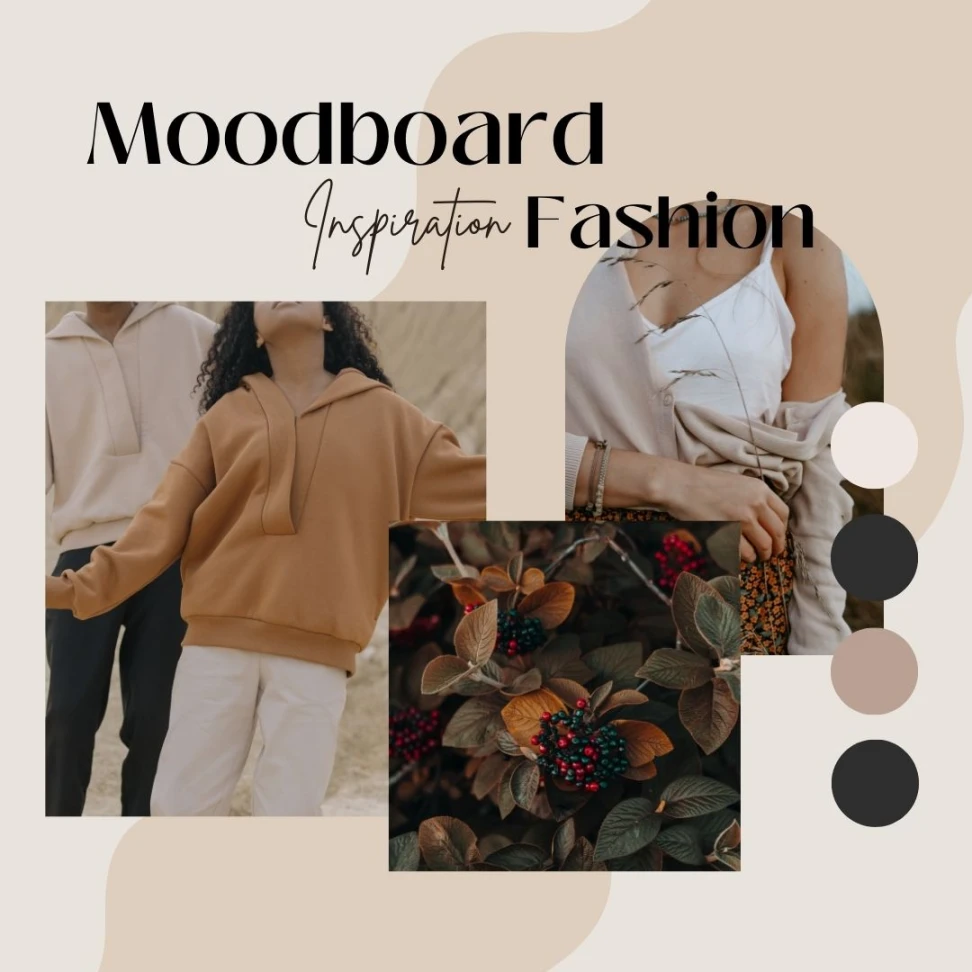
Creating a mood board is a simple and creative process that can help you develop and refine your ideas for a fashion design project. You can make mood boards both digitally and physically. Here are some common steps to follow to create a mood board.
Step 1: Define the purpose
The first step in creating a fashion moodboard is defining its purpose. What is this moodboard for? Is it for a specific clothing line you are designing, a particular season, or a photoshoot concept? The moodboard will serve as your visual guide, so knowing what it is for will help you decide on the appropriate images, textures, and colors to include.
Step 2: Research
After identifying the purpose, your next step is research. Look for inspiration everywhere - fashion magazines, books, newspapers, websites, Pinterest, Instagram, art, nature, architecture, etc. Save all the images, quotes, color swatches, or even pieces of fabric that align with your vision. Don't limit yourself during this stage - the aim is to gather as many ideas as possible.
Step 3: Choose Your Medium
Decide how you want to present your fashion moodboard. It can be digital (using software like Adobe Photoshop, Canva, or even a simple PowerPoint) or physical (using a pinboard or foam board and sticking it on your collected materials). Both mediums have their advantages. Digital is easy to share and edit, while physical gives you a better sense of texture and scale.
Step 4: Sorting and Selecting
Now comes the refinement stage. Review all your collected materials, and select the ones that best communicate your fashion concept. Look for common themes, color schemes, or feelings that stand out. Discard images that don't fit into these themes.
Step 5: Placement and Layout
Start placing your selected items on your fashion moodboard. This stage allows you to play around with the layout until you are happy with its appearance. You might group images by color, theme, or any other criteria that makes sense for your project. Try to create a balance between different types of images and elements.
Step 6: Review
Take a step back and review your fashion moodboard. Does it project the mood, theme, or concept you initially had in mind? Is there a good balance of color, texture, and space? Don’t be afraid to edit, add or remove items and rearrange elements.
Step 7: Presentation
The last step is to present your fashion moodboard. You might want to save it as a PDF or JPEG if it's digital. If it’s physical, take a high-quality photo to share it digitally. Always explain your fashion moodboard to others (clients, teammates) to ensure they understand your concept and ideas.
Remember, a mood board is a fluid tool that can evolve as your ideas do. It's not set in stone, and it's there to serve your creative process. You can always return to it, adjust and tweak it as your vision for your fashion line becomes clearer.
So, creating a mood board is a fun and flexible way to organize and visualize your design ideas and inspirations. With a little creativity and experimentation, you can create a mood board that captures the essence of your design project and helps you communicate your vision to others.
What to Include on a Fashion Mood Board?
A fashion mood board can include various elements that help convey your design's theme, style, and direction. Here's a list of things you might want to include:
1. Images: These can be pictures of clothes, accessories, people, landscapes, or any other image that inspires you. They could be cut from magazines, printed from the internet, or even your own photos.
2. Color Swatches: Colors play a key role in setting the mood for your designs. Including color swatches from paint chips or created digitally can help you decide on a color scheme.
3. Textures: If you're working with textiles, including samples of fabrics or photos of textures can be useful. This can help you visualize how different fabrics might work together.
4. Sketches or illustrations: If you've done some preliminary sketches of your designs, include these on your fashion mood board. They can help bring your concept to life and make it feel more tangible.
5. Keywords or phrases: Words can also evoke mood and inspire designs. If certain words or phrases resonate with your concept, include these on your fashion moodboard.
6. Inspirational Figures or Icons: If a person or character embodies the style or attitude you're aiming for, include photos or images of them.
7. Patterns or Prints: If you plan to use any specific patterns or prints in your designs, including these is a good idea.
8. Accessories and Details: Small details can make a big difference in fashion. If there are particular accessories, buttons, trims, or other details you're considering, include these.
Remember, there's no right or wrong way to create a mood board. The goal is to create something that inspires you and helps guide your design process. It can be as minimal or as detailed as you like. You can always add or remove elements as your vision evolves.
From Where to Collect Fashion Mood Board Inspirations?
Now the big question is from where to collect our mood board inspirations. There are many sources from which you can collect inspiration for your mood board, including:
Fashion Magazines: This is an age-old source of fashion inspiration. Fashion and lifestyle magazines are a great source of inspiration for fashion designers. Look for images, colors, and textures that appeal to you and cut them out to add to your mood board.
Newspapers: The fashion-related articles in newspapers are a great source of inspiration and can provide information for your project.
Pinterest: This social media platform is like a digital inspiration board. You can create boards for different themes or styles and save pins that resonate with you. Searching for terms like "street style", "spring fashion", "vintage fashion", or anything else that interests you will yield tons of results.
Instagram: Follow fashion influencers, designers, and models that inspire you. Many fashion-focused accounts gather and share outfit ideas, current trends, and more.
Fashion Blogs and Websites: Websites like Man Repeller, Who What Wear, and The Sartorialist constantly post up-to-date, fashionable content.
Movies, TV Shows, and Music Videos: Characters' styles in visual media can be a great source of fashion inspiration. Look for shows, movies, or music videos known for their stylish wardrobes. If you notice the well-known Saash-Bahu serials, ignoring the basic content, they are nice to watch the attire of the actors and actresses and the interior designs.
Fashion Shows: Attending fashion shows, or watching them online, can provide you with a wealth of inspiration. Designers' collections from fashion weeks can give you a sense of the upcoming trends and timeless styles. Websites like Vogue provide extensive coverage and high-quality images of these shows. Look for styles, fabrics, and color combinations that go with you.
Nature: The colors, shapes, and textures found in the natural world can be surprisingly inspiring. The changing of the seasons can also give you ideas about colors and layers. Take photos of the landscapes, plants, and animals you encounter. The elements of nature can be beautiful motifs for your project.
Art and Photography: Paintings, sculptures, photographs, and other visual art forms can also be used as fashion inspiration. Not only can the art subjects inspire you, but the colors, composition, and emotion of the piece can influence your fashion sense too.
Social Media: Social media platforms like Instagram, TikTok, and YouTube are great sources of inspiration for fashion designers. Follow fashion influencers and designers, and search for relevant hashtags to find inspiration.
Street Style: Observing what people are wearing on the street, especially in fashionable cities like Manchester, Mumbai, Bangalore, New York, Paris, and Milan, can give you a sense of what styles are popular and practical.
Historical and Cultural References: Different historical periods and cultures worldwide have unique fashion styles. These can be a great source of inspiration, particularly if you want to create something different.
Remember, inspiration can come from anywhere, so keep an open mind and be receptive to the world around you. Collect as many images, colors, and textures as you can and use them to create a mood board that accurately reflects your vision for your fashion design project.
Mood Board Format
Mood boards can take many formats, depending on the designer's preference and the project's needs. Here are some of the most common formats for creating mood boards:
Physical Boards
A physical mood board is a collage of images, textures, and colors that are assembled on a board, usually made of foam board or cork. Physical mood boards allow designers to see and touch the materials, which can be helpful when selecting fabrics and textures. This board is easier to make if you lack digital and electronic resources. Besides, it is easy to attach the paper cutting, photographs, and fabric swatches you have collected.

Digital Boards
Digital mood boards are created using online tools such as Canva, Adobe Photoshop, or Illustrator. Digital mood boards allow designers to work quickly and efficiently and easily share their designs with clients and collaborators, even if they are far from you. You can use Adobe Illustrator, Adobe Photoshop, Corel Draw, Inkspace, Canva, Paint Shop Pro, etc.
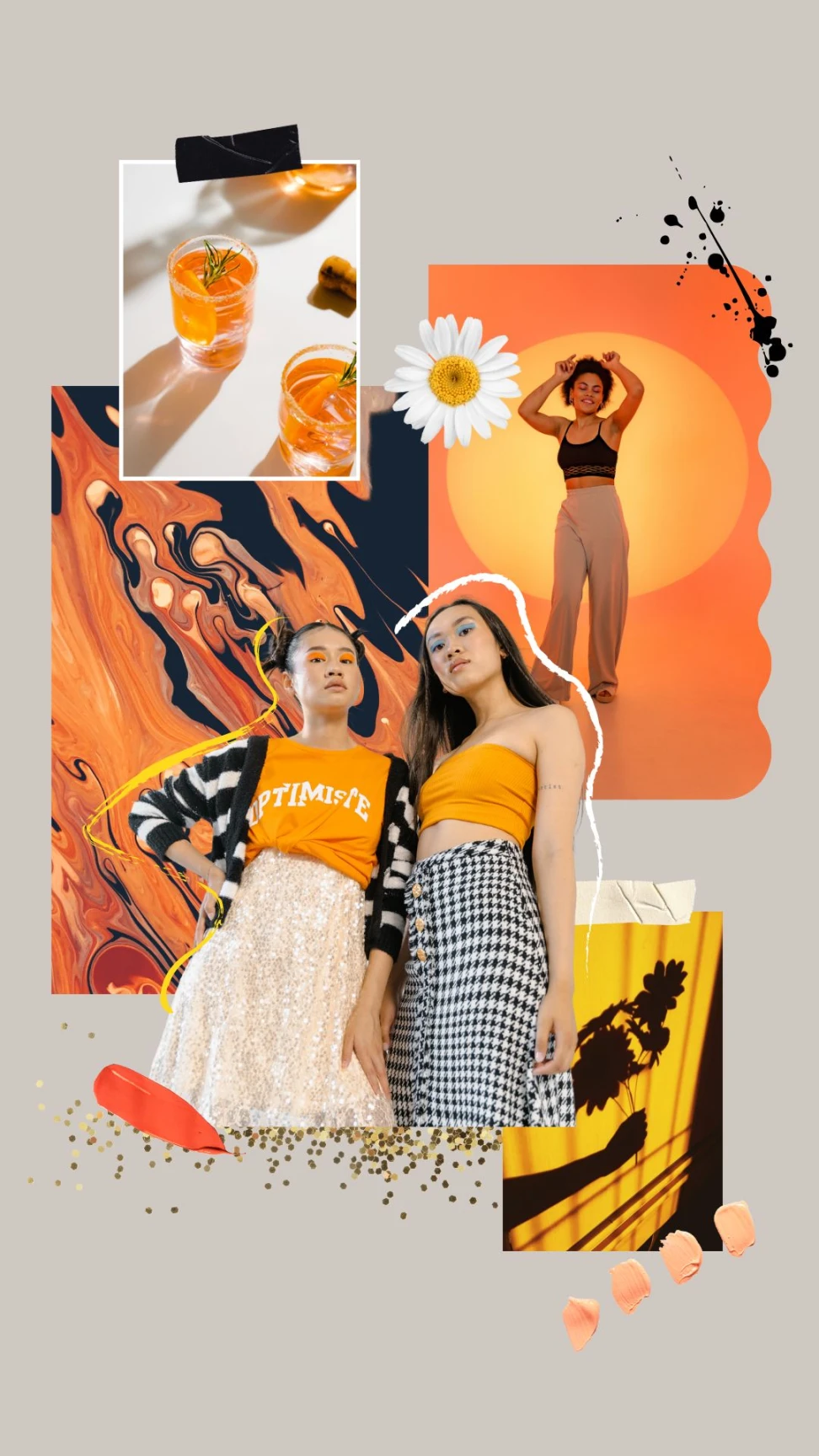
Sketchbooks
Some designers prefer to create mood boards in a sketchbook or journal. This format allows for more flexibility and creativity, as designers can draw, sketch, and add written notes alongside their images and textures.
PowerPoint or Keynote Presentations
Some designers create mood boards as PowerPoint or Keynote presentations, using slides to organize images, colors, and textures. This format is particularly useful for presenting designs to clients and collaborators. For this purpose, you may use MS Powerpoint, Keynote, Prezi, etc.
3D models
For fashion designers working on product design or fashion accessories, 3D models can be an innovative way to present the mood board. This format allows for a more accurate visualization of the end product and can be easily shared digitally. For this, you may use CLO 3D, Maya, Zbrush, etc.
Ultimately, the format you choose for your mood board will depend on your design project's requirements and your personal preferences. Whichever format you choose, remember that the purpose of the mood board is to communicate the overall aesthetic and feel of your design project, so make sure it accurately represents your vision and conveys the right message to your audience.
Moodboard Softwares
Many software options are available for creating mood boards, ranging from free to paid options. Here are some most popular mood board software options:
Canva
Canva is a popular graphic design tool that offers a range of templates and tools for creating mood boards with large customization options.
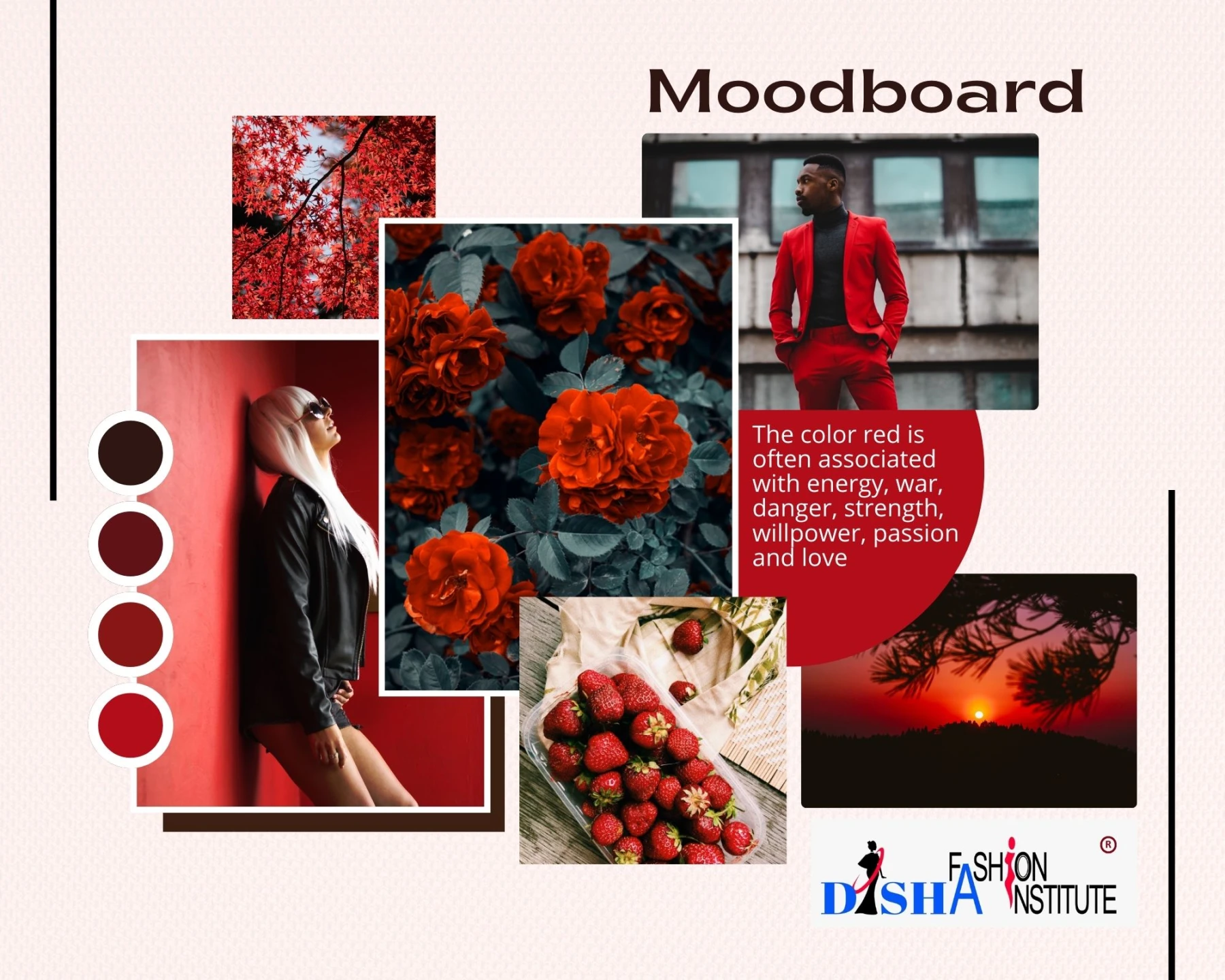
Adobe Creative Cloud
Adobe Creative Cloud is a suite of software that includes Photoshop, Illustrator, and InDesign. These tools offer advanced features for creating mood boards, such as the ability to edit and manipulate images and graphics, and even texts.
Milanote
Milanote is an online tool that allows you to create mood boards and organize your ideas in a visual format and offers a wide range of templates and tools, including the ability to add notes and comments to your images.
Miro
Miro is a collaborative online whiteboard that can be used for creating mood boards and other visual brainstorming activities. It offers a range of templates and tools for creating mood boards, as well as the ability to collaborate with others in real-time.
Pinterest is a free online platform that allows you to create mood boards by pinning images from around the web. It is easy and free to use, has a large library of images, and offers many customization options.
Which Mood board is better: Physical or Digital?
The choice between physical and digital mood boards ultimately comes down to personal preference and the needs of the project. Both formats have their advantages and disadvantages, and the decision will depend on what works best for the designer and the project.
Physical mood boards allow designers to see and touch the materials, which can be helpful when selecting fabrics and textures. They can also be useful for presenting ideas to clients in a tactile way. However, physical mood boards can be time-consuming to create and may be difficult to transport or share with remote collaborators.
Digital mood boards are quick and easy to create and can be easily shared with remote collaborators. They can also be easily edited and updated as the design evolves. However, digital mood boards do not provide the same tactile experience as physical boards, which may be important for some designers and clients. They should be careful while selecting fabrics and trims for their product.
Ultimately, the choice between physical and digital mood boards depends on the designer's personal preference and the needs of the project. Some designers may choose to use a combination of both formats, creating a physical board for initial inspiration and then moving to a digital format for refinement and collaboration.
Conclusion
In conclusion, a mood board is a vital tool for fashion designers, as it helps them to visually convey their creative vision, ideas, and inspirations to clients, stakeholders, and team members. It enables them to organize their thoughts, brainstorm new concepts, and experiment with different colour schemes, textures, and patterns. Customers can understand the designer’s vision and identity through mood boards. Additionally, it facilitates effective communication between designers, clients, and manufacturers, ensuring that everyone is on the same page regarding the project's vision and direction. Besides, manufacturers can understand the desired aesthetics and quality of materials used in the designs. Thus, they can estimate their budget and can operate to meet clients’ expectations. By using mood boards, designers can develop a clear and compelling narrative for their designs, resulting in successful and impactful collections that meet their creative vision and the expectations of their clients.
We dedicate countless hours to crafting study materials for fashion design students through this blog. Our posts encompass various topics from the fashion design syllabus. If you have any suggestions, questions, or doubts, please feel free to share them in the comment section below.

